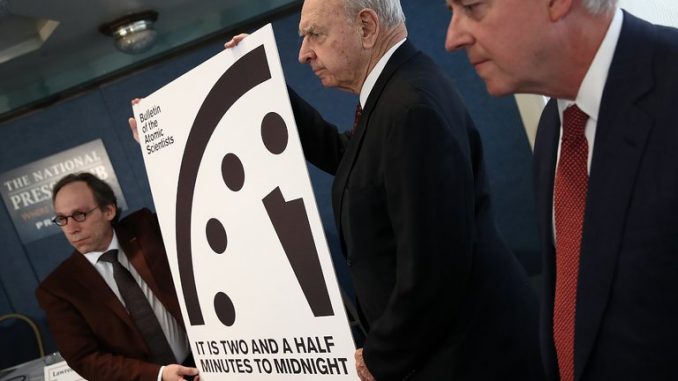
Scientists moved the ‘Doomsday Clock’ 30 seconds closer to midnight on Thursday, meaning humanity is the closest it has ever been to armageddon.
Comments made by President Trump on nuclear weapons and climate change sparked scientists and scholars from the Bulletin of the Atomic Scientists to move the hands of the clock to two and a half minutes to midnight.

BYPASS THE CENSORS
Sign up to get unfiltered news delivered straight to your inbox.
You can unsubscribe any time. By subscribing you agree to our Terms of Use
Latest Video
The clock was last changed in 2015, from five to three minutes before midnight.
CNN.com reports:
It marks the first time since 1953 — after hydrogen bomb tests in the US and then Soviet Union — that humanity has been this close to global disaster.
The group cited US President Donald Trump’s “disturbing comments” about the use of nuclear weapons and views on climate change among other factors, including cyberthreats and the rise in nationalism, that have contributed to the darkened forecast.
“The board’s decision to move the clock less than a full minute reflects a simple reality: As this statement is issued, Donald Trump has been the US president only a matter of days,” the organization said in a statement.
The emblematic clock had remained at three minutes to midnight for the past two years.
In a statement released earlier this week, the Bulletin of Atomic Scientists said it was taking a number of recent developments into account.
“A rise in strident nationalism worldwide, President Donald Trump’s comments on nuclear arms and climate issues, a darkening global security landscape that is colored by increasingly sophisticated technology, and a growing disregard for scientific expertise,” were among them, it said.
A team of Nobel laureates at the Bulletin of Atomic Scientists has been compiling research and analysis to set the “Doomsday Clock” since 1945.
The independent nonprofit group uses data to assess global threats linked to treaty negotiations, geopolitical tensions and developments in the world of technology.
In 1963, scientists moved the clock back to 12 minutes from seven after US and Soviet leaders signed the Partial Test Ban Treaty, ending all atmospheric nuclear testing.
The hand reverted to seven minutes from midnight in 1968 as France and China joined the nuclear arms race, and the US became more involved in the Vietnam War.
However, the pressure eased — and the clock ticked back — with the signing of the nuclear non-proliferation treaty in 1970.
In subsequent years it has swung back and forth — landing at an alarming three minutes to midnight in 1984 when US-Soviet relations reached a new low — before swinging back to 17 minutes from midnight in 1991 after the end of the Cold War.
Since then, it’s ticked ever closer to midnight.
While geopolitical factors feature heavily in this year’s evaluation, emerging risks posed by new technologies have also been flagged for the damage they might reap if they fall into the wrong hands.
These include the rise of artificial intelligence and security threats, including the potential misuse of biotechnology.
Developments in this industry — which enables humans to synthesize organisms from scratch — come with a risk that bio-terrorists will make weapons out of synthetic viruses.
This would widen an already diverse arsenal of weaponry that threatens to end the world.


